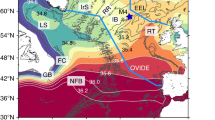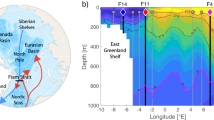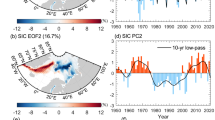Abstract
The tropical Atlantic upper-ocean circulation experiences multiannual to decadal changes associated with different climate modes and is simultaneously adjusting to climate warming. The most energetic current in the tropical Atlantic is the Equatorial Undercurrent (EUC), which flows eastwards along the Equator. On the basis of long-term moored observations, we show that the EUC strengthened by more than 20% from 2008 to 2018. The intensification of the EUC is associated with increasing subsurface oxygen concentrations and a thickening of the upper-ocean oxygenated layer in the equatorial Atlantic. These changes counteract climate-warming-induced deoxygenation in the region. The EUC strengthening is found to be mainly forced by trade wind changes in the western tropical North Atlantic. A 60-yr dataset reveals that the recent oxygen increase in the upper equatorial Atlantic is associated with multidecadal variability. This variability is characterized by low oxygen concentrations in the 1990s and early 2000s, and high oxygen concentrations in the 1960s and 1970s. The observed oxygen variability seems to be linked to a compression and expansion of the habitat of tropical pelagic fish, and must be accounted for when evaluating the possible consequences of deoxygenation for marine ecosystems and fisheries.
This is a preview of subscription content, access via your institution
Access options
Access Nature and 54 other Nature Portfolio journals
Get Nature+, our best-value online-access subscription
$29.99 / 30 days
cancel any time
Subscribe to this journal
Receive 12 print issues and online access
$259.00 per year
only $21.58 per issue
Buy this article
- Purchase on Springer Link
- Instant access to full article PDF
Prices may be subject to local taxes which are calculated during checkout



Similar content being viewed by others
Code availability
All necessary code for the data analysis and preparation of the figures of this manuscript is freely available at https://doi.org/10.5281/zenodo.4478285.
References
Yang, H. et al. Intensification and poleward shift of subtropical western boundary currents in a warming climate. J. Geophys. Res. Oceans 121, 4928–4945 (2016).
Todd, R. E. et al. Global perspectives on observing ocean boundary current systems. Front Mar. Sci. 6, 423 (2019).
Rahmstorf, S. et al. Exceptional twentieth-century slowdown in Atlantic Ocean overturning circulation. Nat. Clim. Change 5, 475–480 (2015).
Frajka-Williams, E. et al. Atlantic Meridional Overturning Circulation: observed transport and variability. Front Mar. Sci. 6, 260 (2019).
Hu, S. J. et al. Deep-reaching acceleration of global mean ocean circulation over the past two decades. Sci. Adv. 6, eaax7727 (2020).
Hazeleger, W. & Drijfhout, S. Subtropical cells and meridional overturning circulation pathways in the tropical Atlantic. J. Geophys. Res. Oceans 111, C03013 (2006).
Zhang, D. X., McPhaden, M. J. & Johns, W. E. Observational evidence for flow between the subtropical and tropical Atlantic: the Atlantic subtropical cells. J. Phys. Oceanogr. 33, 1783–1797 (2003).
Schott, F. A., McCreary, J. P. & Johnson, G. C. in Earth Climate: The Ocean-Atmosphere Interaction Geophysical Monograph 147 (eds Wang, C. et al.) 261–304 (American Geophysical Union, 2004).
Fratantoni, D. M., Johns, W. E., Townsend, T. L. & Hurlburt, H. E. Low-latitude circulation and mass transport pathways in a model of the tropical Atlantic Ocean. J. Phys. Oceanogr. 30, 1944–1966 (2000).
Rabe, B., Schott, F. A. & Kohl, A. Mean circulation and variability of the tropical Atlantic during 1952-2001 in the GECCO assimilation fields. J. Phys. Oceanogr. 38, 177–192 (2008).
Luo, Y. Y., Rothstein, L. M. & Zhang, R. H. Response of Pacific subtropical-tropical thermocline water pathways and transports to global warming. Geophys. Res. Lett. 36, L04601 (2009).
Duteil, O., Böning, C. W. & Oschlies, A. Variability in subtropical-tropical cells drives oxygen levels in the tropical Pacific Ocean. Geophys. Res. Lett. 41, 8926–8934 (2014).
Schott, F. A. et al. The shallow and deep western boundary circulation of the South Atlantic at 5°−11°S. J. Phys. Oceanogr. 35, 2031–2053 (2005).
Hummels, R. et al. Interannual to decadal changes in the western boundary circulation in the Atlantic at 11°S. Geophys. Res. Lett. 42, 7615–7622 (2015).
Johns, W. E. et al. Zonal structure and seasonal variability of the Atlantic Equatorial Undercurrent. Clim. Dynam. 43, 3047–3069 (2014).
Brandt, P., Funk, A., Tantet, A., Johns, W. & Fischer, J. The Equatorial Undercurrent in the central Atlantic and its relation to tropical Atlantic variability. Clim. Dynam. 43, 2985–2997 (2014).
Stramma, L., Johnson, G. C., Sprintall, J. & Mohrholz, V. Expanding oxygen-minimum zones in the tropical oceans. Science 320, 655–658 (2008).
Deutsch, C., Brix, H., Ito, T., Frenzel, H. & Thompson, L. Climate-forced variability of ocean hypoxia. Science 333, 336–339 (2011).
Brandt, P. et al. On the role of circulation and mixing in the ventilation of oxygen minimum zones with a focus on the eastern tropical North Atlantic. Biogeosciences 12, 489–512 (2015).
Montes, E. et al. Decadal variability in the oxygen inventory of North Atlantic subtropical underwater captured by sustained, long-term oceanographic time series observations. Glob. Biogeochem. Cycles 30, 460–478 (2016).
Ito, T. & Deutsch, C. Variability of the oxygen minimum zone in the tropical North Pacific during the late twentieth century. Glob. Biogeochem. Cycles 27, 1119–1128 (2013).
Duteil, O., Schwarzkopf, F. U., Böning, C. W. & Oschlies, A. Major role of the equatorial current system in setting oxygen levels in the eastern tropical Atlantic Ocean: a high-resolution model study. Geophys. Res. Lett. 41, 2033–2040 (2014).
Hahn, J., Brandt, P., Schmidtko, S. & Krahmann, G. Decadal oxygen change in the eastern tropical North Atlantic. Ocean Sci. 13, 551–576 (2017).
Oschlies, A., Brandt, P., Stramma, L. & Schmidtko, S. Drivers and mechanisms of ocean deoxygenation. Nat. Geosci. 11, 467–473 (2018).
Schmidtko, S., Stramma, L. & Visbeck, M. Decline in global oceanic oxygen content during the past five decades. Nature 542, 335–339 (2017).
Breitburg, D. et al. Declining oxygen in the global ocean and coastal waters. Science 359, eaam7240 (2018).
Leung, S., Thompson, L., McPhaden, M. J. & Mislan, K. A. S. ENSO drives near-surface oxygen and vertical habitat variability in the tropical Pacific. Environ. Res. Lett. 14, 064020 (2019).
Stramma, L. et al. Expansion of oxygen minimum zones may reduce available habitat for tropical pelagic fishes. Nat. Clim. Change 2, 33–37 (2012).
Schott, F. A. et al. The zonal currents and transports at 35°W in the tropical Atlantic. Geophys. Res. Lett. 30, 1349 (2003).
Kolodziejczyk, N., Bourlès, B., Marin, F., Grelet, J. & Chuchla, R. Seasonal variability of the Equatorial Undercurrent at 10°W as inferred from recent in situ observations. J. Geophys. Res. Oceans 114, C06014 (2009).
Bourlès, B. et al. PIRATA: a sustained observing system for tropical Atlantic climate research and forecasting. Earth Space Sci. 6, 577–616 (2019).
Foltz, G. R. et al. The tropical Atlantic observing system. Front. Mar. Sci. 6, 206 (2019).
Wacongne, S. Dynamical regimes of a fully nonlinear stratified model of the Atlantic Equatorial Undercurrent. J. Geophys. Res. Oceans 94, 4801–4815 (1989).
Chang, P. et al. Climate fluctuations of tropical coupled systems - the role of ocean dynamics. J. Clim. 19, 5122–5174 (2006).
Hormann, V. & Brandt, P. Atlantic Equatorial Undercurrent and associated cold tongue variability. J. Geophys. Res. Oceans 112, C06017 (2007).
Tuchen, F. P., Lübbecke, J. F., Schmidtko, S., Hummels, R. & Böning, C. W. The Atlantic subtropical cells inferred from observations. J. Geophys. Res. Oceans 124, 7591–7605 (2019).
Schott, F. A., Fischer, J. & Stramma, L. Transports and pathways of the upper-layer circulation in the western tropical Atlantic. J. Phys. Oceanogr. 28, 1904–1928 (1998).
Levin, L. A. Manifestation, drivers, and emergence of open ocean deoxygenation. Annu. Rev. Mar. Sci. 10, 229–260 (2018).
Vaquer-Sunyer, R. & Duarte, C. M. Thresholds of hypoxia for marine biodiversity. Proc. Natl Acad. Sci. USA 105, 15452–15457 (2008).
Deutsch, C. et al. Centennial changes in North Pacific anoxia linked to tropical trade winds. Science 345, 665–668 (2014).
Stramma, L., Oschlies, A. & Schmidtko, S. Mismatch between observed and modeled trends in dissolved upper-ocean oxygen over the last 50 yr. Biogeosciences 9, 4045–4057 (2012).
Bopp, L. et al. Multiple stressors of ocean ecosystems in the 21st century: projections with CMIP5 models. Biogeosciences 10, 6225–6245 (2013).
Rousseaux, C. S. & Gregg, W. W. Recent decadal trends in global phytoplankton composition. Glob. Biogeochem. Cycles 29, 1674–1688 (2015).
Zhang, R. & Delworth, T. L. Simulated tropical response to a substantial weakening of the Atlantic thermohaline circulation. J. Clim. 18, 1853–1860 (2005).
Knight, J. R., Folland, C. K. & Scaife, A. A. Climate impacts of the Atlantic Multidecadal Oscillation. Geophys. Res. Lett. 33, L17706 (2006).
Frajka-Williams, E., Beaulieu, C. & Duchez, A. Emerging negative Atlantic Multidecadal Oscillation index in spite of warm subtropics. Sci. Rep. 7, 11224 (2017).
Delworth, T. L. & Mann, M. E. Observed and simulated multidecadal variability in the Northern Hemisphere. Clim. Dynam. 16, 661–676 (2000).
Yuan, T. L. et al. Positive low cloud and dust feedbacks amplify tropical North Atlantic Multidecadal Oscillation. Geophys. Res. Lett. 43, 1349–1356 (2016).
Ramon, J., Lledó, L., Torralba, V., Soret, A. & Doblas-Reyes, F. J. What global reanalysis best represents near-surface winds? Q. J. R. Meteorol. Soc. 145, 3236–3251 (2019).
CCMP: Cross-Calibrated Multi-Platform Wind Vector Analysis (NCAR, 2017); https://climatedataguide.ucar.edu/climate-data/ccmp-cross-calibrated-multi-platform-wind-vector-analysis
Hollowed, A. B. et al. Projected impacts of climate change on marine fish and fisheries. ICES J. Mar. Sci. 70, 1023–1037 (2013).
Risien, C. M. & Chelton, D. B. A global climatology of surface wind and wind stress fields from eight years of QuikSCAT scatterometer data. J. Phys. Oceanogr. 38, 2379–2413 (2008).
Large, W. G., McWilliams, J. C. & Doney, S. C. Oceanic vertical mixing - a review and a model with a nonlocal boundary-layer parameterization. Rev. Geophys. 32, 363–403 (1994).
von Storch, H. & Zwiers, F. W. Statistical Analysis in Climate Research (Cambridge Univ. Press, 2001).
Rousseeuw, P. J. & Croux, C. Alternatives to the median absolute deviation. J. Am. Stat. Assoc. 88, 1273–1283 (1993).
Olsen, A. et al. GLODAPv2.2019 – an update of GLODAPv2. Earth Syst. Sci. Data 11, 1437–1461 (2019).
Acknowledgements
This study was funded by EU H2020 under grant agreement 817578 TRIATLAS project, by the Deutsche Forschungsgemeinschaft as part of the Sonderforschungsbereich 754 “Climate–Biogeochemistry Interactions in the Tropical Ocean” and through several research cruises with RV Meteor and RV Maria S. Merian and by the Deutsche Bundesministerium für Bildung und Forschung (BMBF) as part of the projects NORDATLANTIK (03F0443B) and RACE-Synthese (03F0824C). R. Kopte was supported by the Underway Research Data project of the German Marine Research Alliance. R. Kiko was also supported by a Make Our Planet Great Again grant of the French Agence Nationale de la Recherche under the “Programme d’Investissements d’Avenir” reference ANR-19-MPGA-0012. We thank the captains, crews, scientists and technical groups involved in the different national and international research cruises to the tropical Atlantic that contributed to collecting shipboard and mooring data and making them freely available. Some of the velocity and oxygen observations were acquired within the PIRATA project and the CLIVAR TACE programme.
Author information
Authors and Affiliations
Contributions
P.B. designed the long-term measurement programme, supervised the data analysis and wrote the first version of the manuscript. J.H. analysed shipboard sections along 23° W. S.S. analysed historical and recent oxygen data. F.P.T. analysed moored velocity data. R. Kopte, F.P.T. and J.H. calculated and analysed EUC transport time series. J.H. and F.P.T. analysed different wind products. R. Kiko, B.B., R.C. and M.D. contributed additional data and expertise on equatorial ocean dynamics and oxygen changes. All authors discussed the results and wrote the manuscript.
Corresponding author
Ethics declarations
Competing interests
The authors declare no competing interests.
Additional information
Peer review information Nature Geoscience thanks Dongxiao Zhang, Nicolas Gruber and the other, anonymous, reviewer(s) for their contribution to the peer review of this work. Primary Handling Editor: Tom Richardson.
Publisher’s note Springer Nature remains neutral with regard to jurisdictional claims in published maps and institutional affiliations.
Supplementary information
Supplementary Information
Supplementary Figs. 1–10, Tables 1–5 and discussion on oxygen changes along the 23° W meridian between 5° S and 14° N
Rights and permissions
About this article
Cite this article
Brandt, P., Hahn, J., Schmidtko, S. et al. Atlantic Equatorial Undercurrent intensification counteracts warming-induced deoxygenation. Nat. Geosci. 14, 278–282 (2021). https://doi.org/10.1038/s41561-021-00716-1
Received:
Accepted:
Published:
Issue Date:
DOI: https://doi.org/10.1038/s41561-021-00716-1
This article is cited by
-
Evidences and drivers of ocean deoxygenation off Peru over recent past decades
Scientific Reports (2021)



